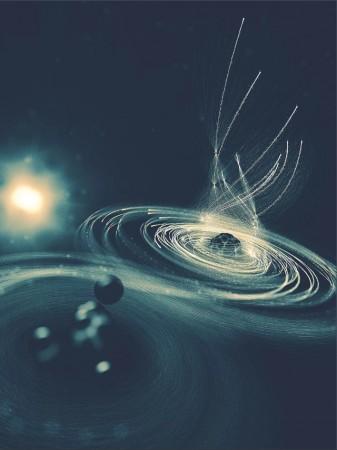
A molecular 'black hole' has been created by the most powerful X-ray laser in the world. This amazing discovery has been made by scientists at the Department of Energy's SLAC National Accelerator Laboratory.
Also Read: Is Moon habitable? NASA's LRO discovers water ice on the lunar surface's south pole
It was found that when the X-ray energy was aimed at a molecule, most of the electrons were stripped away and a void was left behind, that started sucking in electrons from the rest of the molecule just like a black hole eats away a spiralling disk of matter.
The experiment, led by Rolles and Artem Rudenko of Kansas State, took place at LCLS's Coherent X-ray Imaging instrument (CXI). Sebastien Boutet, a physicist at the SLAC National Accelerator Laboratory in Menlo Park, California, was the co-author of this research.
"They are about a hundred times more intense than what you would get if you focused all the sunlight that hits the Earth's surface onto a thumbnail," Boutet said.
"It basically sucked all the electrons away from the surrounding environment. It's an analogy to how a black hole gravitationally pulls everything in," he added.
The one of a kind high-energy X-ray beam is the reason behind the occurrence of this black hole effect, which is equal to focusing all the sunlight that hits the Earth's surface onto a thumbnail.
The experiments were carried out with the help of SLAC's Linac Coherent Light Source X-ray free-electron laser, which produces hard X-rays -- intense laser pulses.
Special mirrors were used by the researchers to focus the X-ray beams into a spot over 100 nanometres in diameter. One nanometer is equal to one-billionth of a metre.
Individual xenon atoms and molecules of iodomethane (CH3I) and iodobenzene (C6H5I) were illuminated because of the focused laser pulses. The researchers tuned the strong energy in such a way that the X-rays would first get stripped from the innermost shells of the iodine atoms, which create hollow atoms.
Based on earlier studies with less energetic X-rays, they thought cascades of electrons from the outer parts of the atom would drop down to fill the vacancies, only to be kicked out themselves by subsequent X-rays. That would leave just a few of the most tightly bound electrons. And, in fact, that's what happened in both the freestanding xenon atoms and the iodine atoms in the molecules, as quoted by the SLAC press release.
But the process didn't halt in the molecules, it was observed that the iodine atom, which had a strong positive charge after it lost most of its electrons continues gobbling the electrons from the neighbouring carbon and hydrogen atoms which were violently ejected one by one.
It was observed that the iodine molecules lost 54 electrons – which included the electrons it gathered from the neighbouring carbon and hydrogen atoms. This level of damage was higher than expected, as well as significantly different in nature.
It just took 30 femtoseconds or one quadrillionth of a second for the entire process to take place. The molecule ended up exploding at the end of this cascade.
"We think the effect was even more important in the larger molecule than in the smaller one, but we don't know how to quantify it yet," Rudenko said. "We estimate that more than 60 electrons were kicked out, but we don't actually know where it stopped because we could not detect all the fragments that flew off as the molecule fell apart to see how many electrons were missing. This is one of the open questions we need to study."
Such a process leading to the formation of a molecular is believed to be occurring for the first time.
"There are some celestial events that will create these intense fields, like supernovas," Boutet said as quoted by Live Science. "It does not happen naturally in any place that we humans happen to be," Rudenko said.










